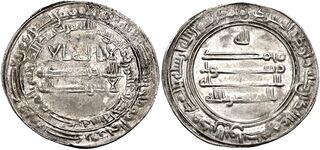حميد بن معيوف الحجوري
حميد بن معيوف الحجوري كان قائداً عربياً في خدمة الدولة العباسية في مطلع القرن التاسع الميلادي.
. . . . . . . . . . . . . . . . . . . . . . . . . . . . . . . . . . . . . . . . . . . . . . . . . . . . . . . . . . . . . . . . . . . . . . . . . . . . . . . . . . . . . . . . . . . . . . . . . . . . . . . . . . . . . . . . . . . . . . . . . . . . . . . . . . . . . . . . . . . . . . . . . . . . . . . . . . . . . . . . . . . . . . . .
السيرة
انحدر حميد من عائلة أشراف عرب استقرت في سهل الغوطة حول دمشق. وبدءاً من جده الأكبر، معيوف بن يحيى الحجوري، خدمت عائلته العباسيين وارتقت في مناصب بلاد الشام.[1]
In 806, according to al-Tabari, Caliph Harun al-Rashid placed him in charge of "the Levant coastlands of the eastern Mediterranean as far as Egypt".[2] Humayd was sent to raid Cyprus, while the Caliph himself led a major invasion of Byzantine Asia Minor. Humayd ravaged the island, carrying off much plunder and 16,000 of its inhabitants, including the local bishop. They were sold as slaves in the markets of al-Rafiqah, under the supervision of the qadi Abu'l-Bakhtari Wahb ibn Wahb.[2][3] In the next year, he sailed on another expedition against the Byzantine Empire, this time targeting Rhodes. The island was plundered, but the city of Rhodes resisted his attempts to capture it. On his return trip, he landed at Myra, where he tried to destroy the tomb of Saint Nicholas. A storm arose, however, sinking some of his ships and forcing him to retire, which the locals attributed to the intervention of the saint.[4][5] It is sometimes considered that before attacking Rhodes, Humayd led his fleet to the Peloponnese, where he either assisted or even fomented a revolt by the local Slavs, leading to the unsuccessful siege of the port city of Patras.[4] It is however possible that the reports of Arab participation in these events are the result of a later interpolation, mixing the real Slavic revolt with subsequent Arab raids.[6]
In the late 810s or the 820s, following a brief tenure by his father, Humayd governed Damascus as deputy to an absent governor of the Jund Dimashq; Paul M. Cobb theorizes that the latter was Nasr ibn Khamza, meaning that Humayd's tenure may have lasted until the appointment of Abu Ishaq, the future al-Mu'tasim, as governor of Syria in 828.[7]
المراجع
- ^ Cobb 2001, pp. 77–78, 96.
- ^ أ ب Bosworth 1989, p. 262.
- ^ Treadgold 1988, pp. 144–145.
- ^ أ ب Treadgold 1988, p. 148.
- ^ PmbZ, Ḥumaid ibn Ma'yūf (#2597).
- ^ Curta 2006, p. 111 (note 1).
- ^ Cobb 2001, pp. 96, 138, 185 (note 104).
المصادر
- Bosworth, C.E., ed. (1989). The History of al-Ṭabarī, Volume XXX: The ʿAbbāsid Caliphate in Equilibrium: The Caliphates of Mūsā al-Hādī and Hārūn al-Rashīd, A.D. 785–809/A.H. 169–192. SUNY Series in Near Eastern Studies. Albany, New York: State University of New York Press. ISBN 978-0-88706-564-4.
- Cobb, Paul M. (2001). White Banners: Contention in 'Abbāsid Syria, 750–880. Albany, NY: State University of New York Press. ISBN 0-7914-4880-0.
- قالب:Southeastern Europe in the Middle Ages, 500–1250
- Lilie, Ralph-Johannes; Ludwig, Claudia; Pratsch, Thomas; Zielke, Beate (2013). Prosopographie der mittelbyzantinischen Zeit Online. Berlin-Brandenburgische Akademie der Wissenschaften. Nach Vorarbeiten F. Winkelmanns erstellt (in German). Berlin and Boston: De Gruyter.
{{cite encyclopedia}}: CS1 maint: unrecognized language (link) - قالب:The Byzantine Revival, 780–842

